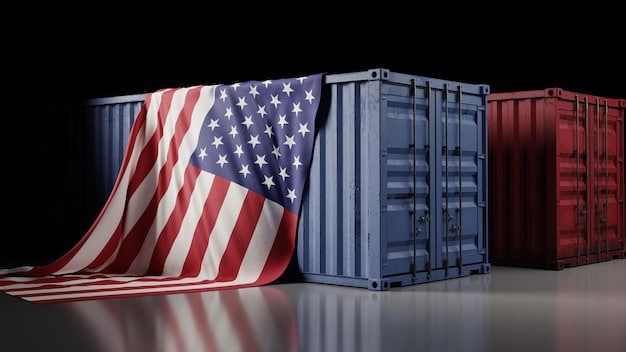Understanding Key Provisions of New Trade Agreements & US Export Impacts

Key provisions of new trade agreements can significantly impact US exports by altering tariffs, quotas, intellectual property rights, and regulatory standards, ultimately influencing market access and competitiveness for American businesses.
Navigating the complexities of international trade can feel like charting a course through uncharted waters, especially when new trade agreements come into play. Understanding what are the key provisions of the new trade agreement and their potential effects on US exports is crucial for American businesses seeking to thrive in the global marketplace. These agreements can open doors to new markets and opportunities, but also pose challenges that require careful consideration and strategic planning.
Decoding Trade Agreements: A Primer for US Exporters
Trade agreements are formal pacts between two or more countries designed to reduce or eliminate barriers to trade and investment. These agreements cover a wide range of issues, from tariffs and quotas to intellectual property rights and regulatory standards. For US exporters, understanding the key provisions of these agreements is essential for navigating the global marketplace effectively.
New trade agreements can dramatically alter the landscape for US exports. By reducing tariffs, for example, American companies can gain a competitive edge in foreign markets, making their products more attractive to consumers. Conversely, changes to intellectual property rights or regulatory standards can create new hurdles for exporters, requiring them to adapt their products and business practices to comply with foreign regulations.

The Scope of Trade Agreements
Trade agreements are not one-size-fits-all; they vary significantly in scope and complexity. Some agreements are bilateral, involving only two countries, while others are multilateral, involving multiple countries. The specific provisions of each agreement depend on the priorities and negotiating positions of the participating countries.
- Tariffs and Quotas: These are among the most common barriers to trade. Trade agreements often aim to reduce or eliminate these barriers to promote the free flow of goods and services.
- Intellectual Property Rights: These agreements can strengthen or weaken intellectual property protections, affecting the ability of US companies to protect their innovations in foreign markets.
- Regulatory Standards: Trade agreements can harmonize or diverge regulatory standards, impacting the cost and complexity of exporting goods and services.
Ultimately, the potential effects of new trade agreements on US exports depend on the specific provisions of the agreement and the industries involved. By carefully analyzing these provisions, US exporters can identify opportunities and challenges and develop strategies to maximize their competitiveness in the global marketplace. Understanding the nuances of these agreements and engaging with policymakers can further help shape trade policy in a way that benefits American businesses.
Tariff Reductions and Their Impact on US Competitiveness
One of the most significant aspects of any trade agreement is the reduction or elimination of tariffs. Tariffs are taxes imposed on imported goods, and they can significantly affect the competitiveness of US exports in foreign markets. When tariffs are reduced or eliminated, American companies can sell their products more cheaply in those markets, making them more attractive to consumers and businesses.
The effect of tariff reductions can be profound, especially for industries that rely heavily on exports. For example, agricultural products, which often face high tariffs in foreign markets, can benefit significantly from tariff reductions. By lowering the cost of these products, US farmers and ranchers can expand their market share and increase their export revenues.

Winners and Losers
While tariff reductions generally benefit US exporters, there can be winners and losers depending on the specific industry and the nature of the trade agreement. Some industries may face increased competition from foreign producers, while others may benefit from access to cheaper inputs or new export opportunities.
- Agriculture: Often benefits from reduced tariffs on agricultural products.
- Manufacturing: May face increased competition from foreign manufacturers, but also gains access to cheaper inputs.
- Technology: Can benefit from stronger intellectual property protections and access to new markets.
It’s important for businesses to carefully analyze the potential effects of tariff reductions on their specific industry and develop strategies to mitigate any negative impacts. This may involve investing in research and development to improve product quality, streamlining production processes to reduce costs, or diversifying into new markets to reduce reliance on tariff-sensitive regions.
The strategic use of tariff reductions can be a powerful tool for enhancing the competitiveness of US exports. However, it’s important for businesses to be aware of the potential risks and challenges and to develop strategies to navigate the changing trade landscape effectively. Understanding the nuances of these agreements and lobbying for policies that support American businesses can further help maximize the benefits of trade liberalization.
Intellectual Property Rights: Protecting US Innovation Abroad
Intellectual property rights (IPR) are crucial for protecting US innovation and competitiveness in the global marketplace. Trade agreements often include provisions related to IPR, such as patents, trademarks, and copyrights. These provisions aim to ensure that US companies can protect their inventions, brands, and creative works in foreign markets, preventing counterfeiting and piracy.
Strong IPR protections can incentivize innovation and investment, as companies are more likely to invest in research and development if they know that their intellectual property will be protected. Conversely, weak IPR protections can stifle innovation and make it more difficult for US companies to compete in foreign markets.
The Impact of IPR Provisions
The specific impact of IPR provisions in trade agreements can vary depending on the nature of the agreement and the countries involved. Some agreements may strengthen IPR protections, while others may weaken them. It’s important for businesses to carefully analyze the IPR provisions of any new trade agreement to understand how it will affect their ability to protect their intellectual property in foreign markets.
For example, agreements that strengthen patent protection can benefit US pharmaceutical companies, allowing them to protect their innovations and charge higher prices for their drugs in foreign markets. On the other hand, agreements that weaken copyright protection may harm US entertainment companies, making it easier for foreign companies to copy and distribute their movies and music without permission.
- Patents: Protect inventions and allow companies to exclude others from making, using, or selling the invention.
- Trademarks: Protect brands and allow companies to prevent others from using similar marks that could confuse consumers.
- Copyrights: Protect creative works, such as books, movies, and music, and allow creators to control how their works are used and distributed.
The effective enforcement of IPR provisions is also crucial. Even if a trade agreement includes strong IPR protections on paper, those protections are meaningless if they are not effectively enforced in practice. US companies should work with government agencies and industry associations to ensure that IPR provisions are effectively enforced in foreign markets.
In summary, strong IPR protections in trade agreements are essential for protecting US innovation and competitiveness in the global marketplace. By carefully analyzing the IPR provisions of new trade agreements and working to ensure that those provisions are effectively enforced, US companies can protect their intellectual property and thrive in the global economy.
Regulatory Standards and Their Role in Trade Facilitation
Regulatory standards play a critical role in international trade, impacting the cost and complexity of exporting goods and services. Trade agreements often include provisions aimed at harmonizing or streamlining regulatory standards to facilitate trade and reduce barriers to entry. These provisions can cover a wide range of issues, from product safety and labeling requirements to environmental regulations and technical standards.
When regulatory standards are harmonized, it becomes easier for US companies to export their products to foreign markets, as they don’t have to comply with different regulations in each country. This can significantly reduce the cost and complexity of exporting, making it easier for small and medium-sized enterprises (SMEs) to participate in international trade.
Challenges and Opportunities
However, harmonizing regulatory standards can also present challenges. Different countries may have different priorities and values, leading to disagreements over which standards should be adopted. Some countries may resist harmonizing their standards if they believe that their own standards are superior or that harmonization would harm their domestic industries.
For example, the European Union (EU) has often been criticized for its strict regulatory standards, which some argue create barriers to trade for US companies. On the other hand, the EU argues that its standards are necessary to protect consumer safety and the environment. Navigating these differences and finding common ground can be a complex and time-consuming process.
- Product Safety Standards: Ensure that products meet certain safety requirements to protect consumers from harm.
- Labeling Requirements: Dictate how products must be labeled to provide consumers with information about their ingredients, origin, and other characteristics.
- Environmental Regulations: Aim to protect the environment by setting standards for pollution control, resource management, and other environmental issues.
Despite the challenges, the potential benefits of harmonizing regulatory standards are significant. By reducing barriers to trade and facilitating the flow of goods and services, regulatory harmonization can boost economic growth and create new opportunities for US exporters. It’s important for businesses and policymakers to work together to find ways to harmonize regulatory standards in a way that benefits all parties involved.
In this landscape, regulatory standards play a vital role in shaping international trade dynamics. Careful consideration and collaboration are essential for fostering a balanced and mutually beneficial global trade environment. By working towards harmonized and streamlined regulations, we can unlock new avenues for economic growth and prosperity for US exporters and their global partners.
Labor and Environmental Provisions: Setting the Stage for Sustainable Trade
In recent years, there has been a growing emphasis on including labor and environmental provisions in trade agreements. These provisions aim to ensure that trade is conducted in a sustainable and responsible manner, protecting workers’ rights and the environment. Labor provisions typically address issues such as child labor, forced labor, and the right to organize and bargain collectively, while environmental provisions address issues such as deforestation, pollution, and climate change.
The inclusion of labor and environmental provisions in trade agreements is often controversial. Some argue that these provisions are necessary to prevent countries from gaining a competitive advantage by exploiting workers or damaging the environment. Others argue that these provisions are protectionist measures that could be used to restrict trade.
Balancing Trade and Sustainability
Despite the controversy, there is a growing consensus that trade agreements should include labor and environmental provisions. Many consumers and businesses are demanding that products be produced in a sustainable and responsible manner, and trade agreements can play a role in promoting these values.
For example, the United States-Mexico-Canada Agreement (USMCA), which replaced the North American Free Trade Agreement (NAFTA), includes strong labor and environmental provisions. These provisions require Mexico to strengthen its labor laws and improve its enforcement of environmental regulations. The USMCA also includes a mechanism for resolving disputes related to labor and environmental issues.
- Worker’s Rights: Protecting fundamental labor rights, including the right to organize, bargain collectively, and work in safe conditions.
- Environmental Protection: Ensuring that trade does not lead to environmental degradation, such as deforestation, pollution, or climate change.
- Enforcement Mechanisms: Establishing mechanisms for resolving disputes related to labor and environmental issues and ensuring that countries comply with their obligations.
The inclusion of labor and environmental provisions in trade agreements is likely to become increasingly common in the future. As consumers and businesses become more aware of the social and environmental impacts of trade, they will demand that trade agreements reflect these concerns. This will require careful negotiation and compromise to ensure that trade is both economically beneficial and socially and environmentally sustainable.
As we move forward, balancing economic prosperity with social responsibility and environmental stewardship will be paramount. By setting the stage for sustainable trade, we can pave the way for a more ethical and equitable global economy that benefits both current and future generations.
Navigating the Trade Landscape: Strategies for US Exporters
The global trade landscape is constantly evolving, and US exporters must be proactive in adapting to new trade agreements and regulations. This requires a deep understanding of the key provisions of these agreements and their potential effects on US exports. It also requires developing strategies to navigate the challenges and capitalize on the opportunities that these agreements present.
One of the most important strategies for US exporters is to diversify their export markets. By exporting to multiple countries, companies can reduce their reliance on any single market and mitigate the risks associated with trade barriers or economic downturns. Diversification can involve expanding into new regions or targeting niche markets within existing regions.
Building Resilience
Another important strategy is to invest in research and development to improve product quality and competitiveness. By developing innovative products that meet the needs of foreign consumers, US companies can gain a competitive edge in the global marketplace. This may involve investing in new technologies, improving product design, or adapting products to local tastes and preferences.
For instance, understanding cultural nuances can be pivotal. Tailoring products to resonate with local preferences demonstrates a commitment to meeting the unique needs of consumers in different regions.
- Market Research: Conduct thorough market research to identify potential export markets and understand the needs and preferences of foreign consumers.
- Trade Finance: Utilize trade finance tools, such as export credit insurance and factoring, to manage the risks associated with international trade.
- Government Support: Take advantage of government programs and services that support US exporters, such as export promotion programs and trade missions.
Finally, it’s important for US exporters to stay informed about changes in trade policy and regulations. This may involve monitoring news and publications related to international trade, attending trade shows and conferences, or working with trade associations and government agencies. By staying informed, companies can anticipate changes in the trade landscape and adapt their strategies accordingly.
In order to successfully navigate the trade landscape and seize the opportunities that trade agreements offer, proactive adaptation and resilience are key. By implementing these strategies, US exporters can leverage the benefits of global trade while mitigating potential risks, ultimately fostering long-term growth and sustainability in an ever-changing world.
| Key Aspect | Brief Description |
|---|---|
| 🌍 Tariff Reductions | Lower tariffs can boost US exports by making goods more competitive. |
| 🛡️ IPR Protection | Strong IPR protection helps US firms safeguard innovations abroad. |
| 🤝 Regulatory Standards | Harmonized standards reduce trade barriers and facilitate exports. |
| 🌱 Sustainability | Labor and environmental provisions promote responsible global trade. |
Frequently Asked Questions (FAQ)
▼
Tariffs are taxes on imported goods; lower ones can reduce the cost of US exports making them more competitive in foreign markets, potentially increasing sales and market share.
▼
They safeguard US innovation abroad by preventing counterfeiting; also, they ensure that American companies can protect their inventions, brands, and creative works.
▼
Harmonizing them reduces complexity for US exporters, meaning they don’t have to comply with different regulations in each country. Also, this streamlining can significantly lower trade barriers.
▼
These ensure trade is sustainable by protecting workers’ rights and the environment; as such, provisions reflect growing consumer demands for responsible production practices globally.
▼
Diversifying markets by lowering reliance on single regions would enable them to take advantage of government support programs, and monitoring policy changes will allow them to adjust accordingly.
Conclusion
In conclusion, understanding the complexities and key provisions of new trade agreements is crucial for US exporters aiming to thrive in the global market. By navigating tariff reductions, protecting intellectual property rights, adapting to regulatory standards, and embracing sustainable trade practices, American businesses can unlock new opportunities and build resilience in an ever-evolving international landscape.





